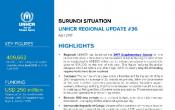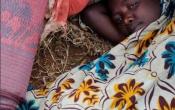Rwanda
Operation: Rwanda
Location
{"longitude":30,"latitude":-2,"zoom_level":8}
Latest update of camps and office locations 21 Nov 2016. By clicking on the icons on the map, additional information is displayed.
Key Figures
| 2016 end-year results | |
| 73% | of Congolese and almost 100% of Burundian refugee children under 12 months old were registered and issued with birth certificates |
| 2,800 | dual semi-permanent shelters were completed, replacing emergency shelters in Mahama camp, providing 4,055 shelters, thus adequately accommodating 54 per cent of the refugee population |
| 450 | families were supported with cash assistance and some 4,000 returnees received in-kind assistance |
| 100 | urban refugee entrepreneurs received entrepreneurship training |
| 20 | litres of potable water provided per person per day to Mahama and surrounding host villages |
| 2017 planning figures | |
| 3,800 | households in camps will receive cash grants |
| 250 | people of concern in camps will be provided with entrepreneurship or business training |
| 6 | people of concern will share one shelter in camps |
| 100% | reported sexual and gender-based violence (SGBV) incidents will receive legal support |
| 70% | of people of concern in camps will have access to the national education system |
Latest Updates and Related Links
People of Concern
9%
Increase in
2016
2016
| 2016 | 164,080 |
| 2015 | 151,173 |
| 2014 | 80,124 |

[["Refugees",156065],["Asylum-seekers",464],["Returned refugees",6105],["Others of concern",1446]]
Loading ...
Rwanda
< Back
2016
{"categories":[2012,2013,2014,2015,2016,2017],"budget":[47.03959177,46.99329576,51.77383169,123.04000345,101.21378467,104.37818119],"expenditure":[20.00151131,24.80532645,19.3520492,39.48045656,44.64500707,null]}
{"categories":[2012,2013,2014,2015,2016,2017],"p1":[46.26031012,44.64886676,49.14538088,122.417859367,95.18270004,96.81308675],"p2":[null,null,null,null,null,null],"p3":[0.77928165,2.344429,2.62845081,0.622144083,6.03108463,7.56509444],"p4":[null,null,null,null,null,null]}
{"categories":[2012,2013,2014,2015,2016,2017],"p1":[20.00151131,24.79354125,18.31857805,38.96277319,43.36483925,null],"p2":[null,null,null,null,null,null],"p3":[null,0.0117852,1.03347115,0.51768337,1.28016782,null],"p4":[null,null,null,null,null,null]}
Loading ...
CHOOSE A YEAR
- 2014
- 2015
- 2016
- 2017
Working environment
The security situation in Rwanda remained calm despite its location in a region affected by ongoing tensions in Burundi and the Democratic Republic of the Congo.While the Government of Rwanda remained committed to the principle of non-refoulement, maintaining the civilian and humanitarian character of asylum remained challenging due to the volatile security situation.
Returnees continued to be supported; however the lack of land for additional shelters remained a challenge. In October 2016, UNHCR began providing cash grants to returnees.
Population trends
- In 2016, Rwanda hosted some 156,000 refugees, including close to 46 per cent from the Democratic Republic of the Congo, 53 per cent from Burundi, and the remaining 1 per cent from different nationalities.
- Urban refugee population increased by 23 per cent due to increase in demand for registration in Kigali.
- UNHCR supported some 5,600 returnees in Rwanda through cash-based assistance.
Achievements and impact
- UNHCR finalized a strategy on civilian and humanitarian character of asylum, pending validation by the Government of Rwanda.
- Accountability to affected populations improved through inter-agency gender assessments, intention monitoring, awareness-raising on disability inclusion and Prevention of Sexual Exploitation and Abuse (PSEA).
- In line with commitment of the Government, significant efforts were made to advocate for inclusion of refugees in Government, UN agencies and development partner national policies and planning.
Unmet needs
- Planned verification exercise and introduction of Biometric Identity Management System (BIMS) were postponed due to delays in the signing of a data-sharing agreement with the Government.
- Due to lack of resources to implement a full urban refugee strategy, the transfer of urban refugees to camp was unavoidable
- While refugee adolescents fall under the most vulnerable groups, facing high protection risks, activities targeting them specifically remained limited.
- Mainstreaming HIV care and related services for Burundian refugees, such as prevention mother to child mother transmission (PMTCT), voluntary counselling and testing (VCT) and antiretroviral therapy (ART) to the Government HIV program remained unmet.
While the security situation in Rwanda remains calm, the armed conflict close to its border with the eastern Democratic Republic of the Congo (DRC), as well as elections planned in some neighbouring countries, continue to destabilize the region, posing a risk of sudden mass influxes of refugees.
Rwanda has been hosting considerable numbers of refugees, principally from the DRC, as well as from other countries in Africa, for decades. The Government is fully committed to fulfilling its international obligations, acting in good faith in doing so. Rwanda has also been receiving thousands of returnees over the years, in particular since the invocation of the cessation clauses relating to Rwandan refugees in 2013. The Government has been forthcoming in identifying land suitable for reception centres and refugee camps, and continues to play a key role in camp management and coordination.
The main priorities in 2016 will be to build the capacity of the newly established national refugee status determination committee and other concerned Government institutions. Since the refugee population is made up of over 80 per cent women and children, UNHCR will prioritize child protection; the prevention of and response to SGBV; the integration of refugee teachers within the national education system; resettlement for Congolese refugees; return and reintegration of former Rwandan refugees in light of the invocation of the cessation clauses in 2013; improved access to primary health care, reproductive health and HIV; nutrition (targeted to vulnerable groups); referral care in emergencies; and improved access to essential medicines. UNHCR will provide individual shelters for families and gradually replace the pit and mobile latrines with dischargeable latrines; and whenever possible, will maintain or improve the supply of potable water in all camps.
UNHCR anticipates that population movements from the DRC and Burundi into Rwanda will continue in 2016. Another planning assumption is that thousands of Rwandan returnees will continue to repatriate throughout 2016 and beyond. Major constraints in this regard include land pressure in Rwanda, as well as the limited resources of UNHCR, the Government of Rwanda and partners for ensuring that reintegration is meaningful, and that obstacles are monitored and addressed.






